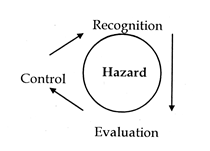Recognition means identification of nature, type and degree of hazard and evaluation means sampling and measurement of the identified hazard by direct reading instrument or laboratory tests and comparing the results with the norms or acceptable levels.
Then follow the control measures to reduce the concentration (amount) below the norms for the purpose of safety and satisfaction.

Recognition (identification and acceptance) and evaluation (measurement and assessment) of the health hazards is the main work of an Industrial Hygienist.
Then in designing and applying the engineering control, he and the Safety Officer have to contribute.
The occupational health physician has to study and detect health effects on workers and to suggest medical measures.
Contents
Industrial hygiene approach
- Identification of health hazards and the extent of their effects on the body.
- Identification of environmental exposures to workers through different routes of entry into the body.
- Recommendation and implementation of process control to reduce exposures and following safe work practices including the use of PPE.
CLICK HERE FOR ? PPE IN FULL DETAILS
Recognition requires knowledge of raw materials, storage conditions, process parameters, byproducts and products, waste generation and disposal, types of industrial operations, process flow sheet, check-list, MSDS, etc.
CLICK HERE FOR ? SAFETY MANAGEMENT ITS RESPONSIBILITIES
Then field surveys should be carried out to identify potential hazards, worst cases and other health hazards. Then by sensory perception and control measures in use, the hazards should be accepted and measured in priority of their severity.
In evaluating or appraising toxic health effects following factors are important
- Nature of substance of exposure i.e. quality of exposure.
- Quantity or concentration of the material.
- Duration or length of exposure.
- State of dispersion (e.g. dust, gas, fume etc.)
- Intensity or severity of the exposure.
- Personal susceptibility or resistance.
- Affinity for human tissue.
- Solubility in humans or organs.
- Sensitivity in human tissue or organs.
There may be wide variations in any of these factors. An environmental survey or study should be carried out to record the toxicity of the substance and workers’ exposure periods.

After collecting such sufficient examples, workers weighted exposure to hazard (dust, gas, fume, vapor etc.) can be calculated.
CLICK HERE FOR ? MSDS
For recognition, the Material Safety Data Sheet (MSDS) is most useful to understand the physical, chemical, fire, explosion and health hazard properties of the material, what, how and when can go wrong and some primary first-aid, medical and spill-control measures also.
CLICK HERE FOR ? FIRST AID (Full details)
Hazards to be recognized should be classified.
- Physical
- Chemical
- Instrumental
- Mechanical
- Electrical
- Biological
- Ergonomic
- Physiological
- Psychological hazards.
Types of some visible hazards
- Poor illumination
- Ventilation
- Temperature
- Noise etc. can be easily recognized by the walk-through survey.
Evaluation techniques include measurement of noise, light, temperature, ventilation, heat stress, collection and analysis of air sample, and comparing with safe or legal limits.
For evaluation either air-samples are collected and tested in the laboratory or by using direct-reading meters the results are obtained.
Recorders can be connected to direct-reading meters to obtain a continuous recording of the meter reading.
It can be plotted with time. Peak concentrations are important when the vapor is irritant, highly odorous or if the subjective complaint is obtained.
The ultimate aim of the evaluation is to take the judgment of the required control measures, after comparing measured values with the acceptable values.
The purpose of the evaluation is to know the type of matter, its concentration, energy and length of time during which it reacts with body tissues.
Dose-response relationship should be known to evaluate the degree of injury. Hazards of noise, vibration, light, radiation, heat etc. need to be measured to keep within permissible or safe limits.
In addition to MSDS, ACGIH values, statutory information (safe limits and control measures), and INTERNET information can also be available nowadays on health hazards, effects reported or known and a variety of preventive and control measures.
Exposure Assessment
“Having a toxic chemical at a workplace does not necessarily mean that it will cause an occupational disease”.
The exposure and toxicity together contribute to causing occupational diseases. Exposure assessment is aimed at defining the extent of exposure to an occupational toxicant that may, or may not, lead to health hazards.
Qualitative exposure assessment
In qualitative exposure assessment, the exposure potential is determined by identifying all exposure sources, determining exposure duration, evaluating the effectiveness of the controls provided and ultimately integrating these data to arrive at a conclusion on the extent of exposure.
The factors evaluated in exposure assessment are, toxicity of the chemical, properties and volume of the chemical used, duration of the exposure, individual tolerance of potentially exposed person, age and gender of the employee, the effectiveness of the exposure control measures provided, the use and effectiveness of personal protective equipment, general work practices such as rest periods, eating or smoking in the workroom, the presence of visible dust or fumes in the atmosphere.
Quantitative exposure assessment
In quantitative exposure assessment, employee exposure to a toxicant is quantified and compared with exposure limits to determine the severity of the exposure.
Various types of monitoring are applied in conducting quantitative exposure assessment such as (1) Direct and Indirect biological monitoring and (2) Air, noise etc. Area or Personal monitoring.
CLICK HERE FOR ? Introduction & Classification of Occupational Health Hazards.





